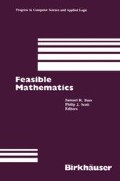Abstract
This expository work discusses the conventional oracle Turing machine model of recursive analysis and proposes an alternative one based on uniform Boolean circuit families. This replacement model is suitable for the study of both sequential and parallel computations. However, for the study of operators, even this model should be replaced by a more structured one based on uniform arithmetic circuit families.
Research supported by the Natural Sciences and Engineering Research Council of Canada, grant OGP 38937.
Access this chapter
Tax calculation will be finalised at checkout
Purchases are for personal use only
Preview
Unable to display preview. Download preview PDF.
References
O. Aberth. Analysis in the computable number field. J. Assoc. Comput. Mach., 15 (1968), pp. 275–299.
O. Aberth. The concept of effective method applied to linear algebra. J. Comput. System Sci., 5 (1971), pp. 17–25.
O. Aberth. The failure in computable analysis of a classical existence theorem for differential equations. Proc. Amer. Math. Soc., 30 (1971), pp. 151–156.
O. Aberth. Computable Analysis. McGraw-Hill. 1980.
J. M. Borwein and P. B. Borwein. On the complexity of familiar functions and numbers. SIAM Rev., 30 (1988), pp. 589–601
E. Bishop. Foundations of Constructive Analysis. McGraw-Hill. 1967.
E. Bishop and D. Bridges. Constructive Analysis. Springer-Verlag. 1985.
L. Blum and M. Shub. Evaluating rational functions: infinite precision is finite cost and tractable on average. Proc 25 IEEE Symp. on Found, of Comp. Sci., 1984, pp. 261–267.
D. S. Bridges. Constructive Functional Analysis. Pitman, London. 1979.
H. Friedman. The computational complexity of maximization and integration. Adv. in Math., 53 (1984), pp. 80–98.
J. von zur Gathen. Algebraic complexity theory. Ann. Rev. Comput. Sci. 3 (1988), 317–347.
A. Grzegorczyk. On the definition of computable real continuous functions. Fund. Math., 44 (1957), pp. 61–71.
A. Grzegorczyk. Some approaches to constructive analysis. In Constructivity in mathematics, A. Heyting, ed. North-Holland. 1959, pp. 43–61.
A. Heyting. Intuitionism. 3rd revised ed. North-Holland. 1976
H. J. Hoover. Feasibly constructive analysis. Ph.D. thesis and Tech. Report 206/87, Department of Computer Science, University of Toronto, Toronto, Canada, 1987.
H. J. Hoover. Real Functions, Contraction Mappings, and P- completeness. Technical report TR89-3, March 1989, Department of Computing Science, University of Alberta, Edmonton, Alberta, Canada.
H. J. Hoover. Feasible Real Functions and Arithmetic Circuits. To appear in SIAM J. Comput., 19(1990).
K. Ko. The maximum value problem and NP real numbers. J. Comput. System Sci., 24 (1982), pp. 15–35.
K. Ko. Some negative results on the computational complexity of total variation and differentiation. Inform, and Control, 53 (1982), pp. 21–31.
K. Ko. Reducibilities on real numbers. Theoret. Comput. Sci., 31 (1984), pp. 101–123.
K. Ko. Applying techniques of discrete complexity theory to numerical computation. In Studies in Complexity Theory, R.V. Book, ed., Pitman, London, 1986, pp. 1 – 62.
K. Ko. Binary search for roots of real functions is inherently sequential. This volume.
K. Ko and H. Friedman. Computational complexity of real functions. Theoret. Comput. Sci., 20 (1982), pp. 323–352.
D. Lacombe. Extension de la notion de fonction recursive aux fonctions d’une ou plusieurs variables réelles. Comptes Rendus 240(1955) pp. 2478–2480, 241(1955) pp. 13–14, 151–153, 1250–1252.
D. Lacombe. Les ensembles récursivement ouverts ou fermés et leurs applications à Vanalyse récursive. Comptes Rendus 244(1957) pp. 838–840, 996–997, 245 (1957) pp. 1040–1043.
A. A. Markov. Theory of Algorithms. 1949. Translated by Jacques J. Schorr-Kon and PST staff, Academy of Sciences of the USSR, Moscow, 1954.
J. Myhill. A recursive function, defined on a compact interval and having a continuous derivative that is not recursive. Michigan Math. J., 18 (1971), pp. 97–98.
M. B. Pour-El and I. Richards. Noncomputability in analysis and physics: a complete determination of the class of noncomputable linear operators. Adv. in Math., 48 (1983), pp. 44–74.
M. O. Rabin.Computable algorithms, general theory and theory of computable fields. Trans. Amer. Math. Soc., 95 (1960), pp. 341–360.
J. C. Shepherdson. On the definition of computable function of a real variable. Z. Math. Logik Grundlag. Math., 22 (1976), pp. 391–402.
E. Specker. Nicht Konstrucktiv Beweisbare Sutze der Analysis. J. Symbolic Logic. 14 (1949), pp. 145–158.
A. M. Turing. On computable numbers, with an application to the entscheidungsproblem. Proc. London Math. Soc., (2), 42 (1936/37), pp. 230–265.
A. M. Turing. A correction. Proc. London Math. Soc., (2), 43 (1937), pp. 544–546.
Author information
Authors and Affiliations
Editor information
Editors and Affiliations
Rights and permissions
Copyright information
© 1990 Birkhäuser Boston
About this chapter
Cite this chapter
Hoover, H.J. (1990). Computational Models For Feasible Real Analysis. In: Buss, S.R., Scott, P.J. (eds) Feasible Mathematics. Progress in Computer Science and Applied Logic, vol 9. Birkhäuser Boston. https://doi.org/10.1007/978-1-4612-3466-1_13
Download citation
DOI: https://doi.org/10.1007/978-1-4612-3466-1_13
Publisher Name: Birkhäuser Boston
Print ISBN: 978-0-8176-3483-4
Online ISBN: 978-1-4612-3466-1
eBook Packages: Springer Book Archive

